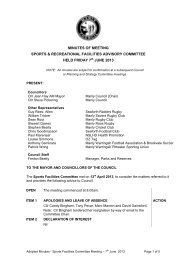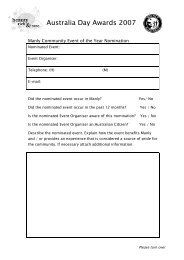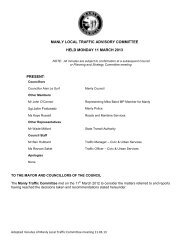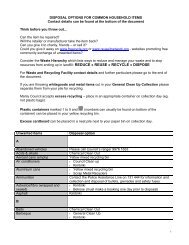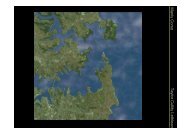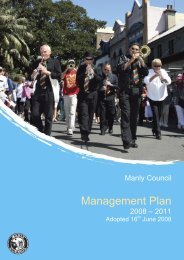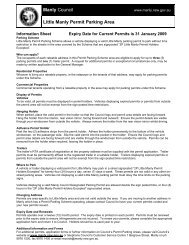Manly Lagoon Dredging Project - Manly Council - NSW Government
Manly Lagoon Dredging Project - Manly Council - NSW Government
Manly Lagoon Dredging Project - Manly Council - NSW Government
- No tags were found...
You also want an ePaper? Increase the reach of your titles
YUMPU automatically turns print PDFs into web optimized ePapers that Google loves.
<strong>Manly</strong> <strong>Lagoon</strong> <strong>Dredging</strong> <strong>Project</strong> – Review of Environmental FactorsPrepared for <strong>Manly</strong> and Warringah <strong>Council</strong>sImpact AssessmentCalculation of the Net Benefit due to the Removal of Contaminants in the SedimentIn order to evaluate the potential water quality benefits of the proposed dredging,calculations were undertaken to consider the net mass or load of material and associatedcontaminants removed from the system. This involved consideration of the mass of materialremoved from the lagoon in the sediments as well as the mass of material returned to thelagoon in the overburden water. The methodology, assumptions and results are shown inAppendix O.The calculation results (Appendix O) show that there is an overall net positive benefitassociated with the proposed dredging with respect to the mass of pollutants removed fromthe system. In particular, the removal of metals (approximately 180 to 210 kg), hydrocarbons(approximately 515 to 590 kg) and nutrients (approximately 595 to 995 kg) is notable.Other Water Quality ImpactsDuring dredging activities the proposed works have the potential to reduce the water qualityof the lagoon over the short term by increasing suspended solids, mobilising sediment-bornecontaminants and facilitating sedimentation processes in the water column. Elevatedturbidity has the potential to harm plant life by decreasing available light, impact on fish byclogging gill structures, or clog respiratory and feeding structures in invertebrates. However,these impacts are expected to be short term and sediments suspended in the water profileare expected to settle on the lagoon bed. Suspended solid levels of 171mg/L were observedin second flush water during the dredging trial. Data on the effects of suspended sedimentson estuarine fish suggest that levels of greater than 600mg/L may be required to cause fishmortality (Wilber and Clark 2001), and hence a short-term level of 171mg/L of suspendedsolids is unlikely to negatively impact on estuarine fish species. In the long term, it isexpected that there will be an improvement in water quality within the lagoon.Disturbing the sediments in <strong>Manly</strong> <strong>Lagoon</strong> may also release nutrients bound up in thesediments into the water column, increasing their biological availability. Elevated nutrientlevels have the potential to promote plant and algal growth.By disturbing the sediment in <strong>Manly</strong> <strong>Lagoon</strong> there is also the potential for exposure ofcontaminated soils or acid sulfate soils. These issues are discussed in Section 5.1.Water quality within the lagoon could also be affected by accidental spills during theproposed works. There is the potential for fuel to be spilled whilst refuelling machinery andequipment on site. There is also the potential for the polymer ULTIMER 7757 or lime to bespilled during dosing of the geobags on site. This risk will need to be managed appropriately.In the long term the proposed works will impact positively on water quality within <strong>Manly</strong><strong>Lagoon</strong>. Removal of the sediment from the lagoon bed is expected to have long term waterquality benefits including:Reduction of levels of contaminants associated with the sediment (Appendix O);2 July 2010 Cardno (<strong>NSW</strong>/ACT) Pty Ltd 64H:\Doc\2010\Reports.2010\Rep2580v4.doc



